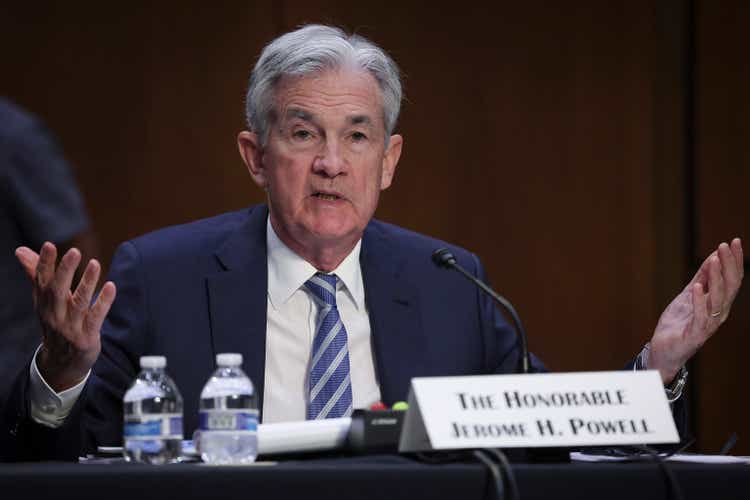Win McNamee
Many hope that the Fed will stop raising rates some time in 2023. Fed officials suggest that it takes up to one year to assess the effect of prior rate increases, so in order not to overly increase rates, likely to increase the chance of a recession, such a pause seems prudent. Lately, whenever the stock market has hoped for either a slowing down of the size of Fed rate increases or a ceasing of these increases altogether, stocks have tended to rally.
In a previous article on Seeking Alpha, I presented my own research showing that the overall stock market tends to do best of all during periods of steady (neither falling nor rising) Fed fund rates. This applies for steady rates over periods of at least a year. Surprisingly, my research implies that if one waits until such rates are actually falling, they may have already missed the best stock advances.
Several Fed officials have indicated they prefer, when inflation starts to seem more likely to return to their 2% goal, not to drop rates immediately, but to enter a period of holding rates steady for a while to see the effect of their prior rate rising actions. Perhaps it will be useful to once again evaluate how stocks have done during such “on hold” Fed periods, as in the above-mentioned article.
When investors expect the Fed to be moving rates either up or down in a close series of steps, it may create added uncertainty, which is something that investors tend to abhor. On the other hand, when the Fed enters a recognizable, stable period, investors may feel most confident in further investing in the stock market. Investors may feel if the Fed isn’t doing anything, it perceives the economy must be more under control.
Of course, in the current situation of rising rates, such a stable period might not happen at all or until beyond 2023. For example, if rates continue to rise without a pause, investors may fear further drops in the stock market. On the other hand, if Fed fund rates start to fall without a pause, investors may sense the Fed has been “forced” into such an action by highly deteriorating economic conditions.
To see what has happened in the past, I examined how stocks, as measured by the S&P 500, performed when the Fed either kept rates steady for at least a year after raising them or after similarly lowering them.
Examining Previous Extended Fed “Standing Pat” Periods
To identify periods of Fed inaction, either after a period of rising rates or one of lowering them, I examined the history of Fed actions over the last 25 years. The following summarizes what I found.
In no case, did the Fed stand pat for a full year and then return to their prior up or down direction as before. Once they started a rate cycle, and then stood pat for a year, they always reversed direction. (Note: That almost happened between Dec. 2015 and Dec. 2016 when they started hiking rates in 2015, paused for nearly a year, but continued hiking the next December; this pause fell short of a full year by a few days. The lengthy pause may have still been perceived favorably by investors; the S&P returned 11.82% during that period.)
This suggests that if they stop raising rates in this up cycle followed by a rest for at least a year, they will likely not raise them again to continue the cycle. Such a pause would be welcome news to investors. An end to rate rises undertaken would likely mean the Fed thinks the current bout of inflation is once again nearing to be under control. But further, this likely would mean considerably better stock market performance than we’ve seen in 2022.
Now let’s look at how the stock market actually did during previous lengthy periods when the Fed held steady. I will use the Vanguard S&P 500 Index Admiral (VFIAX) as a nearly identical performer to the S&P 500 Index.
| Dates |
Prior Fed Cycle Direction |
Return on VFIAX |
| Mar. 25, 1997 Thru Sept. 29, 1998 | Up | 36.11 % |
| June 25, 2003 Thru June 30, 2004 | Down | 18.95 |
| Jun. 29, 2006 Thru Sept. 18, 2007 | Up | 22.11 |
| Dec. 16, 2008 Thru Dec. 17, 2015 | Down | 159.99 |
| Mar 16, 2020 Thru Mar. 17, 2022 | Down | 90.65 |
Note: All returns are not annualized so can be quite large over a number of years.
We can see that these lengthy periods when the Fed held rates steady, regardless of whether rates were previously going up or down, were periods of exceptionally good returns for the S&P 500. Incidentally, the pause period above that might be regarded as most similar to the current situation was between June 2006 and September 2007. During the prior time frame, the Fed had raised interest rates from 1% to 5.25% to attempt to cool the economy and unemployment had begun to rise. It was a ripe time for an interest rate pause and stock prices rose considerably over the period.
To summarize, it appears that investors are likely correct in hoping for a steady Fed this time around because during such past pauses, returns for investors over the last 25 years have been outstanding.


Be the first to comment